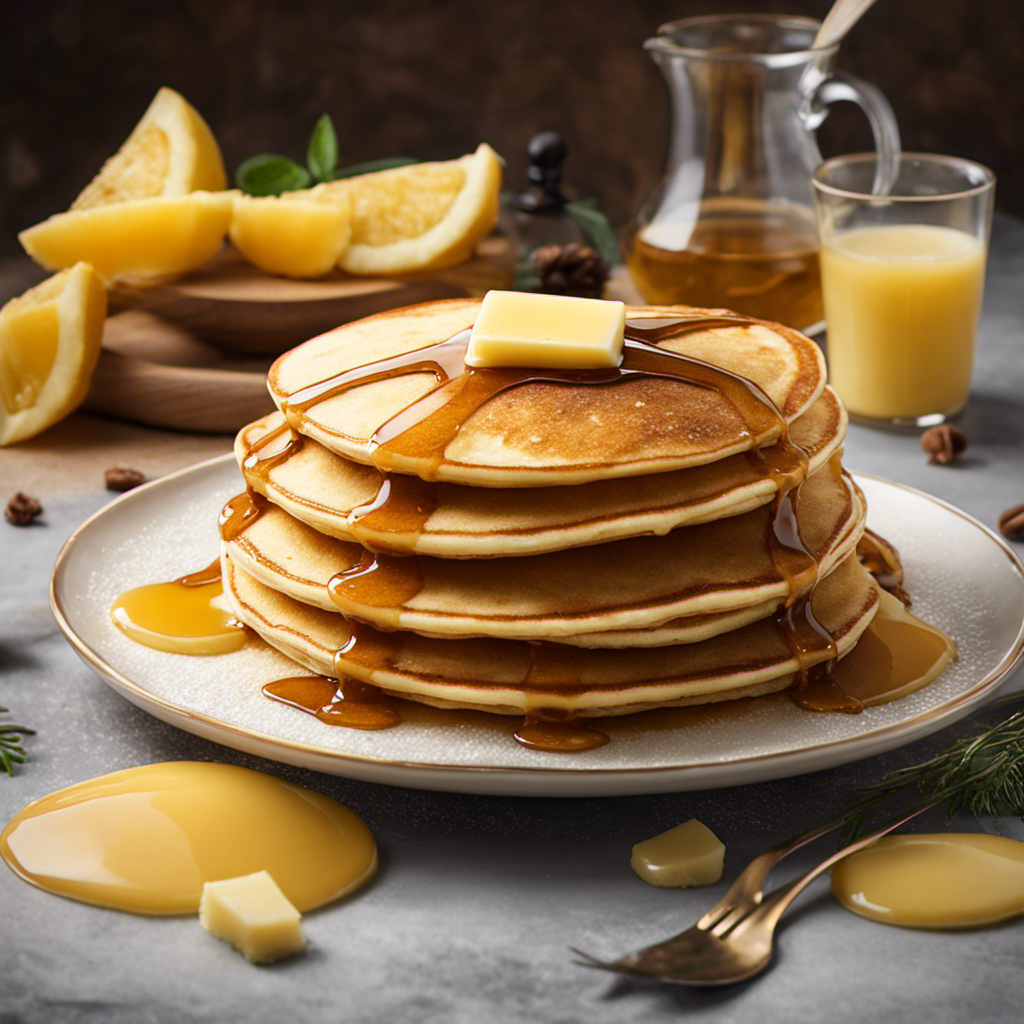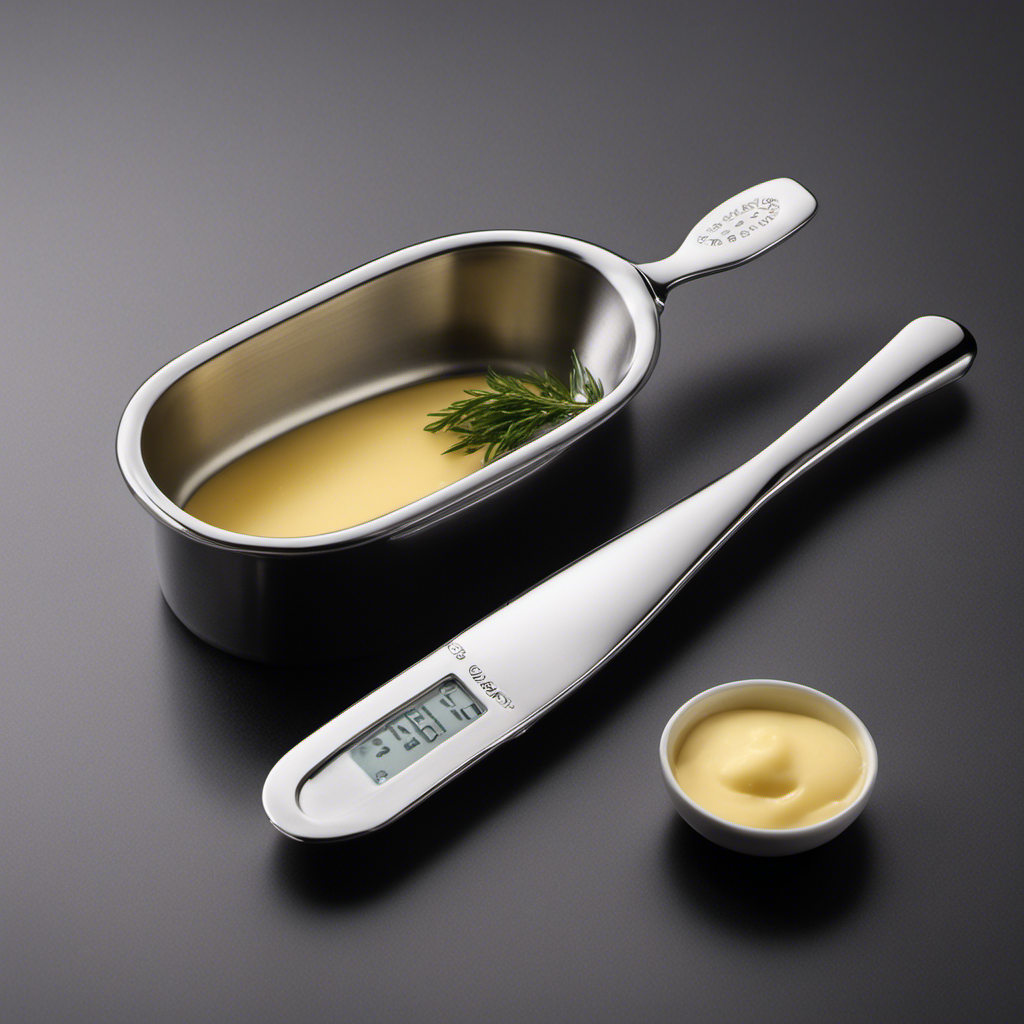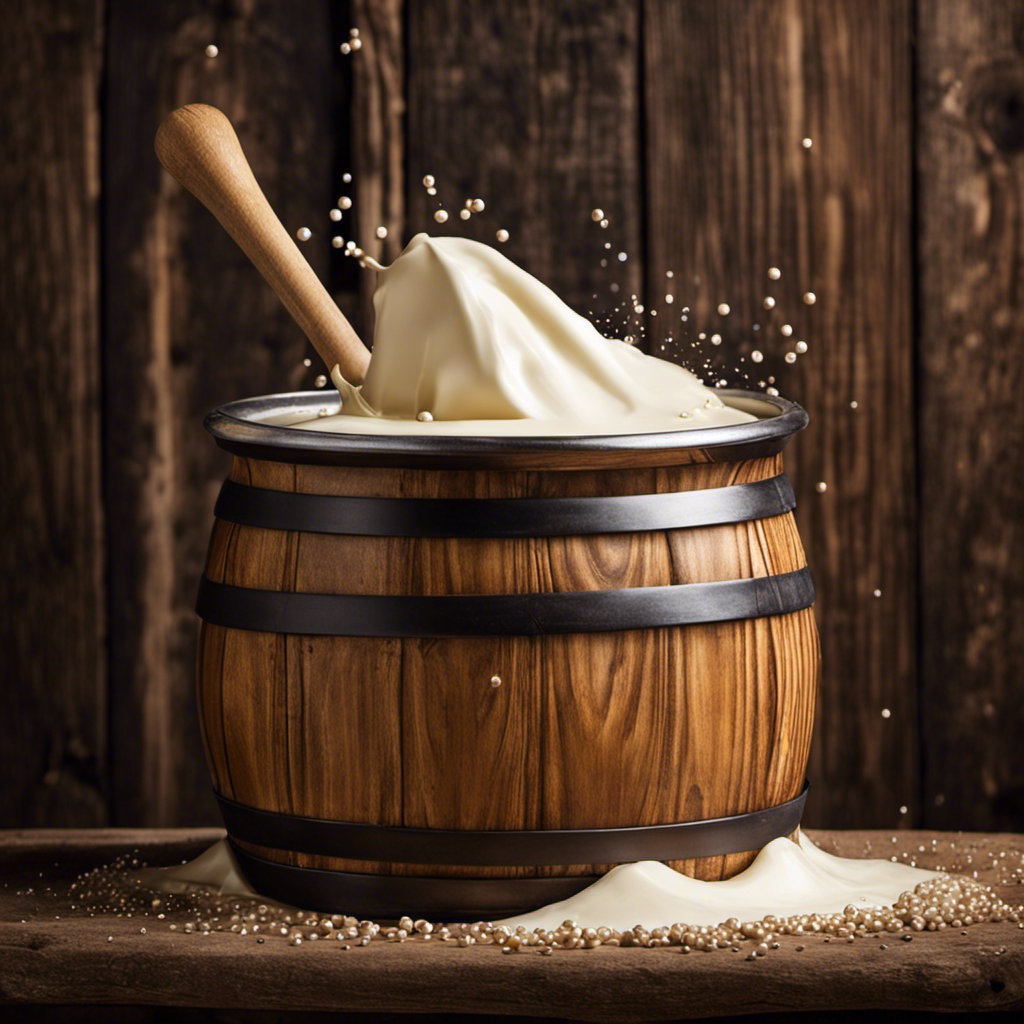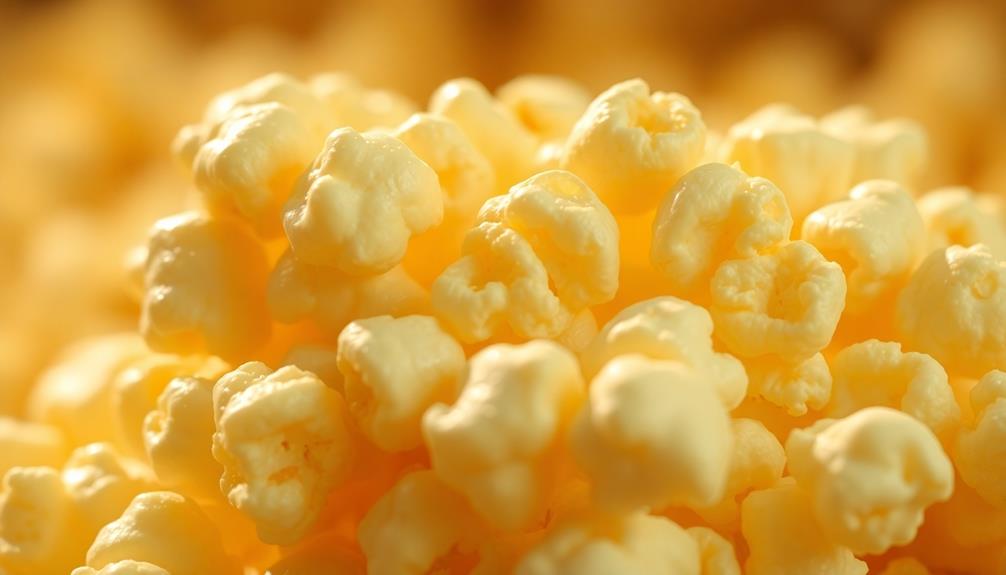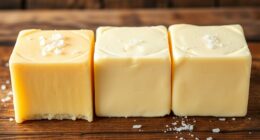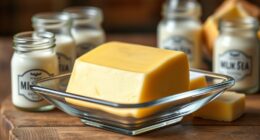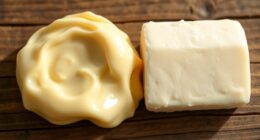I’ve turned every stone, peeked into every corner, on a mission to find the ultimate peanut butter machine. Believe me, fellow peanut butter lovers, it’s no walk in the park.
But fear not, for I have compiled a comprehensive guide to help you find this holy grail of kitchen appliances. From local stores to online retailers, specialty shops to farmers markets, I’ve left no stone unturned.
So sit back, relax, and let me guide you on this delectable journey.
Key Takeaways
- Local kitchen appliance stores, specialty kitchen gadget shops, local kitchen boutiques, and farmers markets are good options to find a peanut butter maker locally.
- Online options such as online kitchen appliance retailers, specialty kitchen gadget shops, specialty peanut butter brands, and online auction websites can provide a wide range of peanut butter makers.
- Price comparison options like Amazon, Walmart, online auction websites, and kitchenware sections of department stores can help find the best deals on peanut butter makers.
- For unique and vintage options, specialty kitchen gadget shops (online and local), second-hand stores and thrift shops, online auction websites, and local thrift stores and garage sales can be explored.
Local Kitchen Appliance Stores
You can find a peanut butter maker at local kitchen appliance stores. These stores offer a variety of options for price comparison, allowing you to find the best deal for your budget. Whether you’re looking for a basic model or a more advanced one with additional features, these stores have a range of options to choose from.
One advantage of shopping at local stores is the ability to see and touch the peanut butter makers before making a purchase. This allows you to get a feel for the quality and durability of the machine. Additionally, the knowledgeable staff at these stores can provide valuable insights and recommendations based on your specific needs and preferences.
In addition to the convenience and customer service, local kitchen appliance stores also offer the advantage of finding rare items. If you’re looking for a specific brand or model that may not be available at larger retailers, these stores may be your best bet. They often have a wider selection of niche products, making it easier to find exactly what you’re looking for.
Overall, local kitchen appliance stores provide a great option for purchasing a peanut butter maker. With their price comparison options and the possibility of finding rare items, these stores offer a personalized shopping experience that can’t be matched by online retailers.
Online Kitchen Appliance Retailers
When it comes to shopping for kitchen appliances online, it can be overwhelming to navigate through the countless options available. However, there are a few online retailers that consistently stand out as the best in terms of selection, customer service, and competitive pricing.
Having access to price comparison options can help ensure that you are getting the best deal possible.
Best Online Retailers
If you’re looking for the best online retailers for a peanut butter maker, Amazon and Walmart are great options. These two giants in the e-commerce industry offer a wide range of products, including kitchen appliances.
Here are four reasons why they are worth considering:
-
Extensive Product Selection: Amazon and Walmart have a vast inventory of peanut butter makers, making it easier for you to find the perfect one for your needs.
-
Competitive Prices: Both retailers offer price comparison options, allowing you to compare prices and choose the best deal for your budget.
-
Customer Reviews: With thousands of customer reviews available, you can make an informed decision based on the experiences of others.
-
Rare Items: If you’re looking for a specific brand or model, Amazon and Walmart often have a greater chance of carrying these rare items.
With these options, you can be confident in finding the peanut butter maker that suits your needs and budget.
Price Comparison Options?
Consider utilizing the price comparison options offered by Amazon and Walmart to make sure you’re getting the best deal on your kitchen appliance purchase. When it comes to finding the best prices, these two retailers are known for their competitive pricing and wide range of products.
Whether you’re looking for a peanut butter maker or any other kitchen appliance, comparing prices can help you save money. Additionally, it’s important to consider other factors such as supporting local farmers and organic options. Both Amazon and Walmart offer a variety of products that cater to these needs.
Specialty Kitchen Gadget Shops
When it comes to finding unique and specialized kitchen gadgets, there are various options to consider.
Online specialty shops provide a wide range of products, from innovative utensils to hard-to-find cooking tools, all conveniently accessible with just a few clicks.
On the other hand, local kitchen boutiques offer a more personalized shopping experience, allowing customers to see and feel the products before making a purchase.
Lastly, exclusive kitchenware retailers cater to those seeking high-end and luxury items, providing a curated selection of top-of-the-line cookware and appliances.
Online Specialty Shops
You can find a peanut butter maker at online specialty shops. These shops offer a wide range of options for those interested in making their own peanut butter at home.
Here are four reasons why online specialty shops are the best place to find a peanut butter maker:
-
Price Comparison Options: Online specialty shops allow you to easily compare prices from different sellers, ensuring that you get the best deal on your peanut butter maker.
-
Specialty Peanut Butter Brands: These online shops often carry specialty peanut butter brands that you may not find in your local grocery store. This gives you access to unique flavors and varieties to experiment with in your homemade peanut butter.
-
Convenience: Shopping online allows you to browse and purchase a peanut butter maker from the comfort of your own home. No need to travel to multiple stores in search of the perfect machine.
-
Customer Reviews: Online specialty shops usually provide customer reviews and ratings for the peanut butter makers they sell. This can be incredibly helpful in making an informed decision about which product to purchase.
Overall, online specialty shops provide a convenient and knowledgeable platform for purchasing a peanut butter maker, offering a wide range of options and the ability to compare prices and explore specialty brands.
Local Kitchen Boutiques
If you’re in need of unique kitchen gadgets, local kitchen boutiques offer a variety of specialty items.
These boutiques are a hidden gem for food enthusiasts, providing a curated selection of high-quality tools and gadgets that you won’t find in big-box stores.
They cater to all kinds of culinary interests, including baking, cooking, and even crafting homemade nut butter recipes.
Not only can you find a peanut butter maker, but you can also explore other innovative gadgets to enhance your cooking experience.
Additionally, many local kitchen boutiques offer cooking classes, giving you the opportunity to learn new techniques and recipes from experienced chefs.
Exclusive Kitchenware Retailers
Local kitchen boutiques are a great place to discover unique and high-quality kitchen gadgets that can’t be found in mainstream stores. Here are four reasons why you should visit these exclusive retailers:
-
Specialty Peanut Butter Brands: These boutiques often carry a wide selection of specialty peanut butter brands. From classic flavors like creamy and crunchy to unique options like honey roasted or spicy, you’ll find a variety of nut butters to satisfy your taste buds.
-
Variety of Nut Butters: In addition to peanut butter, these stores offer a range of other nut butters. Almond, cashew, and hazelnut are just a few of the delicious alternatives you can explore. With different textures and flavors, you’ll never get bored with your nut butter choices.
-
High-Quality Ingredients: The kitchenware retailers source their products from reputable manufacturers who prioritize quality ingredients. This ensures that the nut butters you find are made with the finest nuts, oils, and sweeteners, resulting in a superior taste and texture.
-
Unique Blends and Flavors: If you’re looking to try something different, these boutiques often have exclusive blends and flavors that you won’t find anywhere else. From salted caramel to espresso-infused nut butters, there’s always something exciting to discover.
Farmers Markets
There’s a good chance you’ll find a peanut butter maker at farmers markets. These bustling hubs of local produce and handmade goods are the perfect place to discover unique and artisanal kitchenware. When it comes to finding a peanut butter maker, farmers markets offer a variety of options that cater to different tastes and preferences.
At these markets, you’ll often come across stalls selling homemade nut butters, made with love and care by local vendors. These craft fairs and artisan markets showcase the creativity and passion of small-scale producers, who often offer a wide range of nut butters beyond just peanut. From almond to cashew, hazelnut to macadamia, the choices are endless.
To give you an idea of the delightful options available at farmers markets, here’s a table showcasing the different nut butters you might find:
| Nut Butter | Description |
|---|---|
| Almond | Creamy and slightly sweet, perfect for baking |
| Cashew | Smooth and buttery, great for spreading |
| Hazelnut | Rich and indulgent, pairs well with chocolate |
| Macadamia | Buttery and decadent, a true treat |
| Pecan | Nutty and slightly sweet, great for desserts |
Health Food Stores
Health food stores are a great place to discover a wide range of wholesome and nutritious products. Here are four reasons why health food stores are the perfect destination for anyone looking for specialty peanut butter brands and a variety of nut butters:
-
Extensive Selection: Health food stores offer an impressive array of specialty peanut butter brands, catering to different dietary needs and preferences. From organic and natural options to unique flavors like chocolate or cinnamon, you’ll find a variety of nut butters that suit your taste.
-
Nutritional Benefits: Unlike conventional peanut butters, specialty brands found in health food stores often prioritize high-quality ingredients. They may offer options with no added sugars, hydrogenated oils, or artificial additives, ensuring that you’re getting all the nutritional benefits of nut butter without any unwanted extras.
-
Allergen-Friendly Options: Health food stores also cater to individuals with specific dietary restrictions or allergies. You’ll find nut butter alternatives made from almonds, cashews, or sunflower seeds, perfect for those with peanut allergies or following a Paleo or vegan diet.
-
Support for Small Businesses: Many health food stores pride themselves on stocking products from small, local businesses. By purchasing specialty peanut butter brands from these stores, you’re not only getting delicious and nutritious products but also supporting independent producers and fostering a sense of community.
Supermarkets With Specialty Sections
When it comes to specialty peanut butter brands and the variety of nut butters available, there is an abundance of options to explore.
These specialty brands offer unique and innovative flavors, textures, and ingredients that cater to different tastes and dietary preferences.
From classic peanut butter with a twist to exotic nut butter blends, the supermarket’s specialty section is a treasure trove for nut butter enthusiasts like myself.
Specialty Peanut Butter Brands
If you’re looking for specialty peanut butter brands, you can find them at gourmet food stores or online. These brands offer a variety of peanut spreads that go beyond the typical grocery store options.
Here are four exceptional gourmet peanut butters to consider:
-
Artisana Organics Raw Almond Butter: Made from high-quality, organic almonds, this creamy spread is perfect for those seeking a healthier alternative to traditional peanut butter.
-
Wild Friends Classic Creamy Peanut Butter: This brand takes classic peanut butter to the next level by using only the finest peanuts and a touch of sea salt. It’s smooth, rich, and utterly delicious.
-
BLiS Blast Hot Pepper Bacon Jam: For those who crave a unique flavor combination, this peanut butter is infused with smoky bacon and fiery hot peppers. It’s a bold and savory choice.
-
Big Spoon Roasters Chai Spice Peanut Butter: Combining the warmth of chai spices with the nuttiness of peanuts, this artisanal peanut butter is a delightful twist on a classic spread.
Whether you’re looking for a healthier option, a gourmet flavor experience, or simply something different, these specialty peanut butter brands deliver exceptional quality and taste.
Variety of Nut Butters
You’ll be amazed by the variety of nut butter flavors available, from almond to cashew to hazelnut. These specialty nut butter flavors offer a delightful twist to the classic peanut butter.
Each flavor has its unique characteristics and taste profile, allowing you to explore different options and find your personal favorite. Whether you’re looking for a smooth and creamy almond butter or a rich and decadent cashew butter, there is a flavor to suit every palate.
Not only can you find these specialty nut butter flavors in stores, but you can also make your own at home with homemade nut butter recipes. Experimenting with different combinations of nuts and flavors is a fun and delicious way to enjoy the wide variety of nut butters available.
Craft Fairs and Artisan Markets
To find a peanut butter maker, check out craft fairs and artisan markets. These events often showcase a wide range of unique and handcrafted products, including homemade nut butter makers. Here are four reasons why craft fairs and artisan markets are the perfect places to find a peanut butter maker:
-
Unique Selection: Craft fairs and artisan markets attract a diverse group of vendors, including farmers market vendors and local specialty shops. This means you’ll have access to a variety of peanut butter makers, each with its own unique features and design.
-
Direct Interaction: At these events, you can directly interact with the peanut butter maker vendors. You can ask questions about their products, learn about their processes, and even sample their delicious nut butters. This personal connection allows you to make an informed decision and find the perfect peanut butter maker for your needs.
-
Support Local Businesses: By purchasing a peanut butter maker from a craft fair or artisan market, you’re supporting local businesses and artisans. These vendors often put a lot of love and care into their products, and your purchase helps them continue doing what they love.
-
Discover New Flavors: Craft fairs and artisan markets are known for their unique and innovative food offerings. Alongside the peanut butter makers, you may also find vendors selling flavored nut butters, such as chocolate hazelnut or spicy almond. This is the perfect opportunity to expand your nut butter horizons and try something new.
Home and Kitchen Supply Stores
When shopping at home and kitchen supply stores, don’t forget to explore the wide range of appliances and gadgets available for all your cooking and baking needs. These stores are a treasure trove of kitchen essentials, offering everything from basic utensils to sophisticated appliances.
One of the great advantages of shopping at these stores is the availability of price comparison options. You can easily compare prices and find the best deals on the items you need. Whether you’re looking for a blender, a mixer, or a specialty gadget like a peanut butter maker, these stores have got you covered.
Not only do home and kitchen supply stores offer a wide variety of products, but they also provide a convenient and reliable way to find rare items. If you’re searching for a specific brand or model, chances are you’ll be able to find it at one of these stores. They often stock items that are not commonly found in other retail outlets, making them a go-to destination for those hard-to-find kitchen tools.
In addition to their extensive selection, home and kitchen supply stores offer the expertise of their knowledgeable staff. They can provide valuable advice on the best products for your specific needs and guide you through the purchasing process.
Online Auction Websites
When it comes to online auctions, there are several key points to consider.
First, finding the best auction sites is crucial in order to have a successful bidding experience.
Second, understanding and implementing effective bidding strategies can greatly increase your chances of winning desired items at reasonable prices.
Lastly, for those looking for rare and unique items, knowing how to navigate these auction sites is essential in order to find those hidden treasures.
Best Auction Sites
If you’re looking for the best auction sites to find a peanut butter maker, eBay and ShopGoodwill are great options. These sites offer a wide range of products and have a reputation for being reliable and trustworthy.
Here are four reasons why these auction sites are the best for finding a peanut butter maker:
-
Price comparison options: Both eBay and ShopGoodwill allow you to compare prices from different sellers, helping you find the best deal on a peanut butter maker.
-
Finding rare items: These auction sites have a large user base, increasing your chances of finding rare peanut butter makers that may not be available elsewhere.
-
User reviews: eBay and ShopGoodwill have a review system in place, allowing you to check the reputation of sellers and make informed decisions before bidding.
-
Secure payment options: Both sites offer secure payment options, ensuring that your transactions are safe and protected.
Now that we’ve explored the best auction sites for finding a peanut butter maker, let’s delve into some bidding strategies to help you win that perfect appliance.
Bidding Strategies
When it comes to auction bidding, having a solid strategy in place can make all the difference in securing the best deals. Price negotiation is an essential aspect of successful bidding.
Before the auction begins, I thoroughly research the item I’m interested in, including its market value and any potential flaws or issues. Armed with this knowledge, I set a maximum bid that I’m willing to go up to.
During the auction, I stay focused and avoid getting caught up in bidding wars that could drive the price up unnecessarily. Instead, I bid strategically, waiting for the right moment to make my move.
If the bidding surpasses my predetermined maximum bid, I gracefully bow out. By employing these tactics, I increase my chances of securing the item I want at a price that I’m comfortable with.
Finding Rare Items
In the search for rare items, it’s crucial to explore niche markets and connect with collectors who specialize in those specific items.
Here are four specialty peanut butter brands that offer a variety of nut butters:
-
Nutty Niche: This brand prides itself on sourcing the finest nuts from around the world to create unique and flavorful nut butters. From almond to cashew and everything in between, Nutty Niche offers a wide range of options for nut butter enthusiasts.
-
Rare Roasts: With a focus on small-batch roasting, Rare Roasts produces artisanal peanut butters that are full of rich, complex flavors. Their unique blends, such as espresso-infused or maple pecan, will take your taste buds on a delightful journey.
-
Exotic Eats: For those looking to explore new and exciting flavors, Exotic Eats offers peanut butter blends infused with spices and ingredients from different cuisines. Try their Thai curry or Mexican chocolate peanut butter for a truly unique experience.
-
Gourmet Grinds: Combining high-quality ingredients with innovative flavor combinations, Gourmet Grinds creates peanut butters that are a true indulgence. From salted caramel to lavender honey, their creations are sure to satisfy even the most discerning palate.
These specialty peanut butter brands offer a wide variety of nut butters that cater to different tastes and preferences. Whether you’re a nut butter connoisseur or simply looking to try something new, exploring these niche markets will surely lead you to rare and delectable finds.
Second-Hand Stores and Thrift Shops
You can often find a peanut butter maker at second-hand stores and thrift shops. These places are a treasure trove of unique and interesting items, and a peanut butter maker is no exception.
When searching for one, it’s important to keep a few things in mind. First, be prepared to negotiate the price. Second-hand stores and thrift shops often have flexible pricing, so don’t be afraid to ask for a lower price or make a counteroffer.
Additionally, it’s a good idea to read product reviews before making a purchase. While second-hand items may not come with a warranty, knowing the experiences of others can help you make an informed decision. Look for reviews that mention the condition and functionality of the peanut butter maker, as well as any potential issues or limitations.
Directly From the Manufacturer’s Website
If you’re looking to purchase a product directly from the manufacturer’s website, be sure to check for any available discounts or promotions. Buying directly from the manufacturer can have its advantages, such as getting the product at its original price without any additional markups. Here are four reasons why purchasing directly from the manufacturer’s website can be beneficial:
-
Price Comparison Options: When you buy from the manufacturer’s website, you have the advantage of comparing prices across different brands or models. This allows you to make an informed decision and choose the best product at the most competitive price.
-
Finding Rare Items: Sometimes, manufacturers have exclusive products or limited editions that are not available elsewhere. By purchasing directly from their website, you increase your chances of finding those rare items that might not be stocked by other retailers.
-
Authenticity and Warranty: Buying directly from the manufacturer ensures that you are getting an authentic product with a valid warranty. This eliminates the risk of purchasing counterfeit or substandard items that could be sold by unauthorized sellers.
-
Direct Support and Customer Service: When you buy from the manufacturer’s website, you have direct access to their customer support team. This means that any queries or concerns can be addressed promptly, ensuring a smooth and satisfactory shopping experience.
Kitchenware Sections of Department Stores
When shopping for kitchenware, don’t forget to explore the sections of department stores for a wide variety of options. These sections often have a vast selection of products that can cater to all your cooking needs. From pots and pans to utensils and appliances, you can find everything you need to equip your kitchen.
One of the advantages of shopping for kitchenware in department stores is the price comparison options. You can easily compare prices of different brands and models to ensure you’re getting the best deal. This can be particularly useful when looking for a specific item like a peanut butter maker.
In addition to price comparison, department stores also offer a variety of nut butters. While you may not find a peanut butter maker specifically in the kitchenware section, you can find a wide range of pre-made nut butters. From classic peanut butter to almond butter, cashew butter, and more, the choices are endless.
Exploring the kitchenware sections of department stores can be a great starting point in your search for a peanut butter maker. However, if you’re looking for a more specialized and diverse range of options, you may want to consider attending food and beverage trade shows. These trade shows often feature manufacturers and distributors showcasing their latest products, including peanut butter makers. So, if you’re a peanut butter enthusiast, keep reading to learn more about the exciting options you can find at these trade shows.
Food and Beverage Trade Shows
After exploring the kitchenware sections of department stores, I realized that I needed more options in my search for a peanut butter maker. That’s when I discovered the world of food and beverage trade shows.
These trade shows are a hub for all things related to the culinary industry, showcasing the latest trends and innovations in food and drinks.
Here are four reasons why food and beverage trade shows are the perfect place to find a peanut butter maker:
-
Wide Range of Exhibitors: These trade shows attract a diverse range of exhibitors, including kitchen appliance manufacturers and specialty food vendors. You’ll have the opportunity to explore various booths and find the perfect peanut butter maker that suits your needs.
-
Live Demonstrations: Many exhibitors at these trade shows offer live demonstrations of their products. This means you can witness firsthand how a peanut butter maker works and ask any questions you may have.
-
Networking Opportunities: Food and beverage trade shows are not only great for finding a peanut butter maker, but also for networking with industry professionals. You can connect with experts who can provide valuable insights and recommendations for the best peanut butter makers on the market.
-
Variety of Nut Butters: These trade shows often showcase a wide variety of nut butters, including almond, cashew, and hazelnut. This gives you the chance to explore different flavors and broaden your nut butter horizons.
Attending food and beverage trade shows opens up a world of possibilities for finding the perfect peanut butter maker while also discovering a variety of delicious nut butters.
Online Classified Ad Websites
One option for exploring a wide range of kitchen appliances is to browse online classified ad websites. These websites offer a convenient way to search for and compare prices on various kitchen appliances, including rare items that may be difficult to find elsewhere. I have found that these websites provide a wealth of options for those looking to purchase a peanut butter maker or any other kitchen appliance.
When searching for a peanut butter maker on online classified ad websites, I came across a variety of options at different price points. Here is a comparison of three different listings I found:
| Listing | Price | Condition |
|---|---|---|
| Listing 1 | $50 | Like New |
| Listing 2 | $30 | Used |
| Listing 3 | $80 | Brand New |
As you can see from the table, there are options available at different price ranges and conditions. This allows for a price comparison and the ability to choose the best option based on personal preferences and budget.
In addition to price comparison options, online classified ad websites also provide the opportunity to find rare items that may not be readily available in stores. Whether it’s a vintage peanut butter maker or a specialized model, these websites often have unique listings that cater to a variety of needs and interests.
Overall, browsing online classified ad websites offers a convenient and efficient way to explore a wide range of kitchen appliances, including peanut butter makers. With price comparison options and the ability to find rare items, these websites are a valuable resource for anyone in search of specific kitchen appliances.
Social Media Marketplaces and Buy/Sell Groups
After exploring online classified ad websites, I discovered another avenue to find a peanut butter maker: social media marketplaces and buy/sell groups. These platforms have become increasingly popular for buying and selling items, and they can be a great resource for finding unique and specialized products like a peanut butter maker.
Here are four reasons why you should consider checking out social media marketplaces and buy/sell groups:
-
Wide selection: These platforms attract a diverse range of sellers, which means you’ll have a greater chance of finding a peanut butter maker that suits your needs.
-
Local connections: Many sellers on social media marketplaces and buy/sell groups are located in your area, making it easier to arrange pickup or delivery and potentially saving you shipping costs.
-
Competitive prices: With multiple sellers vying for customers, you may find better deals and more competitive prices compared to other sources.
-
Support local businesses: In addition to individuals selling their pre-loved items, you may also come across craft fairs or health food stores using social media marketplaces as a platform to promote and sell their products, giving you the opportunity to support local entrepreneurs.
Frequently Asked Questions
Can I Make Peanut Butter Using a Regular Blender or Food Processor?
I can make peanut butter using a regular blender or food processor. However, a regular blender may have limitations in achieving a smooth texture, while a food processor offers the benefits of better control and consistency.
Are There Any Specific Recipes or Ingredients That Can Enhance the Flavor of Homemade Peanut Butter?
To enhance the flavor of homemade peanut butter, you can try adding different nuts like almonds or cashews to your peanut butter maker. These nut options can give your peanut butter a unique and delicious taste.
How Long Does Homemade Peanut Butter Last and How Should It Be Stored?
Homemade peanut butter can last for about two to three months if stored properly. The best way to store it is in an airtight container in the refrigerator to maintain its freshness and extend its shelf life.
Are There Any Alternative Nut Options That Can Be Used in a Peanut Butter Maker?
There are several alternatives to peanut butter that can be used in a peanut butter maker. Nut butter recipes can be made with almonds, cashews, or even sunflower seeds for a delicious and nutritious spread.
Can a Peanut Butter Maker Also Be Used to Make Other Nut Butters, Such as Almond or Cashew Butter?
Yes, a peanut butter maker can also be used to make other nut butters like almond or cashew butter. It opens up a world of possibilities for delicious almond butter recipes and the health benefits of cashew butter.
Conclusion
In conclusion, finding a peanut butter maker is not as difficult as it may seem. From local kitchen appliance stores to online retailers, there are plenty of options available. Specialty kitchen gadget shops, farmers markets, and health food stores are also worth exploring. Don’t forget to check out the kitchenware sections of department stores and attend food and beverage trade shows for more choices.
You can even search online classified ad websites and social media marketplaces for used options. So, why wait? Start your peanut butter making journey today and indulge in the creamy, homemade goodness that will leave your taste buds asking for more.



